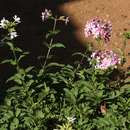en
names in breadcrumbs


Saponaria is a genus of flowering plants in the family Caryophyllaceae, native to Asia and Europe, and are commonly known as soapworts.[1] They are herbaceous perennials and annuals, some with woody bases. The flowers are abundant, five-petalled and usually in shades of pink[2] or white.[1] The genus is closely related to the genus Silene, being distinguished from these by having only two (not three or five) styles in the flower.[2] It is also related to Gypsophila, but its calyx is cylindrical rather than bell-shaped.[3]
The most familiar species might be common soapwort (S. officinalis), which is native to Eurasia but is known in much of the world as an introduced species, often a weed, and sometimes a cultivated ornamental plant.[1] The genus name Saponaria derives from the Latin sapo ("soap") and -aria ("pertaining to"),[1] and at least one species, S. officinalis, has been used to make soap.[4] It contains saponins, and a liquid soap could be produced by soaking the leaves in water.[1] This soap is still used to clean delicate antique tapestries.[5]
Saponaria species are eaten by the larvae of some butterflies and moths, including the Lychnis and Coleophora saponariella, which is exclusive to the genus.
There are thirty[3][6] to forty[1][7][8] species in the genus.
Species include:[9]
Saponaria is a genus of flowering plants in the family Caryophyllaceae, native to Asia and Europe, and are commonly known as soapworts. They are herbaceous perennials and annuals, some with woody bases. The flowers are abundant, five-petalled and usually in shades of pink or white. The genus is closely related to the genus Silene, being distinguished from these by having only two (not three or five) styles in the flower. It is also related to Gypsophila, but its calyx is cylindrical rather than bell-shaped.
The most familiar species might be common soapwort (S. officinalis), which is native to Eurasia but is known in much of the world as an introduced species, often a weed, and sometimes a cultivated ornamental plant. The genus name Saponaria derives from the Latin sapo ("soap") and -aria ("pertaining to"), and at least one species, S. officinalis, has been used to make soap. It contains saponins, and a liquid soap could be produced by soaking the leaves in water. This soap is still used to clean delicate antique tapestries.
Saponaria species are eaten by the larvae of some butterflies and moths, including the Lychnis and Coleophora saponariella, which is exclusive to the genus.